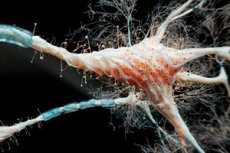Nye publikasjoner
Noen nerveceller utløser betennelse med vilje
Sist anmeldt: 02.07.2025

Alt iLive-innhold blir gjennomgått med medisin eller faktisk kontrollert for å sikre så mye faktuell nøyaktighet som mulig.
Vi har strenge retningslinjer for innkjøp og kun kobling til anerkjente medieområder, akademiske forskningsinstitusjoner og, når det er mulig, medisinsk peer-evaluerte studier. Merk at tallene i parenteser ([1], [2], etc.) er klikkbare koblinger til disse studiene.
Hvis du føler at noe av innholdet vårt er unøyaktig, utdatert eller ellers tvilsomt, velg det og trykk Ctrl + Enter.

Individuelle hjernenerveceller aktiverer immunproteiner for å fikse visse ubehagelige hendelser i minnet.
Minnedannelse er assosiert med transformasjonen av nervecellenettverk. Noen forbindelser mellom nevroner styrkes, andre oppstår, og noen forsvinner. Transformasjoner ledsages av intensive endringer i genene og det molekylære apparatet. Ofte oppdager forskere ett eller annet gen eller proteinstoff som deltar i dannelsen av hukommelse og lagrer informasjon. Imidlertid forblir hele den molekylærgenetiske mekanismen for hukommelsesstøtte et mysterium for oss.
I sitt nylige arbeid beskrev forskerne en gruppe nerveceller som ligger i hippocampus. Mekanismen bak disse strukturene ble relativt tydelig: etter spesiell DNA-skade ble det utløst inflammatoriske prosesser i dem.
Representanter fra A. Einstein School of Medicine utførte et eksperiment på gnagere: under visse forhold ble et svakt elektrisk støt sendt til potene deres, noe som aktiverte metoden for å huske ubehagelige hendelser. Hvis gnageren deretter ble plassert igjen i buret der den opplevde det elektriske støtet, frøs dyret til i alarm, noe som demonstrerte en stressreaksjon. Ifølge forskere dannes det en inflammatorisk reaksjon i visse nerveceller i hippocampus etter stresseksponering, forårsaket av en forbindelse med proteinagensen TLR9, eller toll-lignende reseptorer.
Denne typen reseptorer tilhører klassen medfødt immunforsvar: de reagerer på manifestasjoner som er typiske for store patogene grupper. I nærvær av en trussel starter disse reseptorene visse prosesser i cellestrukturen og informerer naboceller og immunsystemet om problemet som har oppstått.
I vanlige hippocampusnerveceller slås hukommelsesgener raskt på etter DNA-skade. TLR9-proteinet er nødvendig for å sikre at nødvendig informasjon lagres i hukommelsen: da dette proteinet ble slått av, husket ikke gnagerne en ubehagelig situasjon på lenge – spesielt stresset de opplevde når de ble utsatt for elektrisk strøm.
Hvordan aktiveres TLR9? DNA dukket opp i cytoplasmaet til nerveceller, plassert i spesielle membranbobler. Aktiv TLR9 startet DNA-reparasjonsprosessen: samtidig dukket en hel rekke regulatoriske proteiner opp, og DNA-partikler ble gruppert ved celleorganellen - sentrosomet. Dermed startet DNA-partikler som indikerer genomskade, sammen med TLR9 og andre proteinstoffer, DNA-restaurering i cellekjernen. Hele denne prosessen forfulgte bare ett mål - dannelsen av langtidshukommelse.
Til tross for at TLR9 er et immunprotein assosiert med en inflammatorisk respons, finnes det ingen inflammatorisk prosess i ordets fulle forstand: nerveceller fortsetter å fungere og eksistere normalt. Alt som brukes er to lignende mekanismer for immunitet og nevral hukommelse, som har det samme molekylære settet med verktøy. Det er ganske mulig at det fortsatt er forskjeller på noen stadier. Imidlertid må forskere studere disse problemstillingene i senere studier.
Detaljer på siden til tidsskriftet Nature
